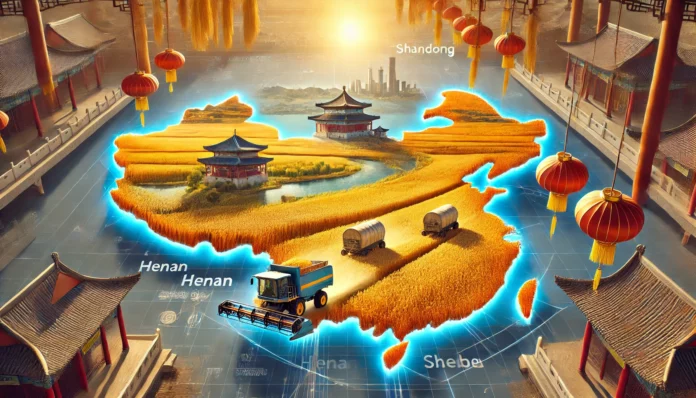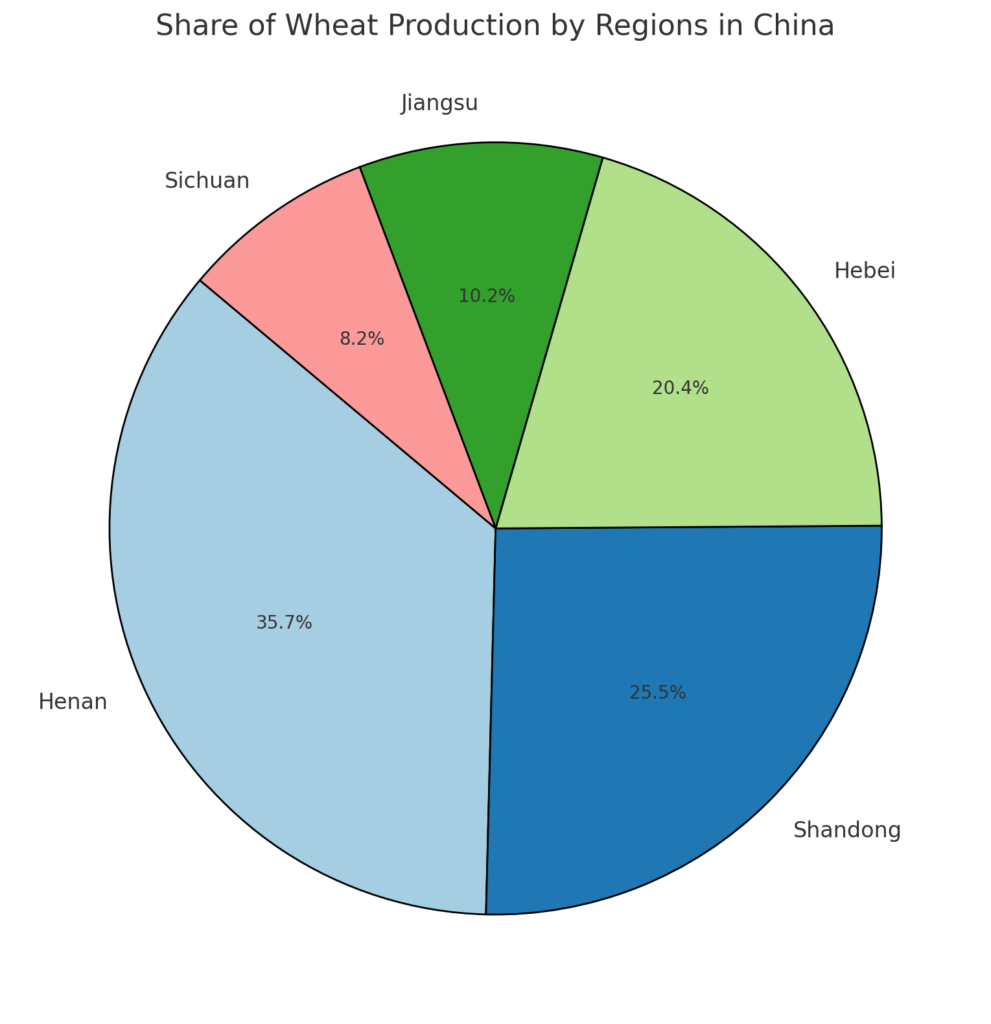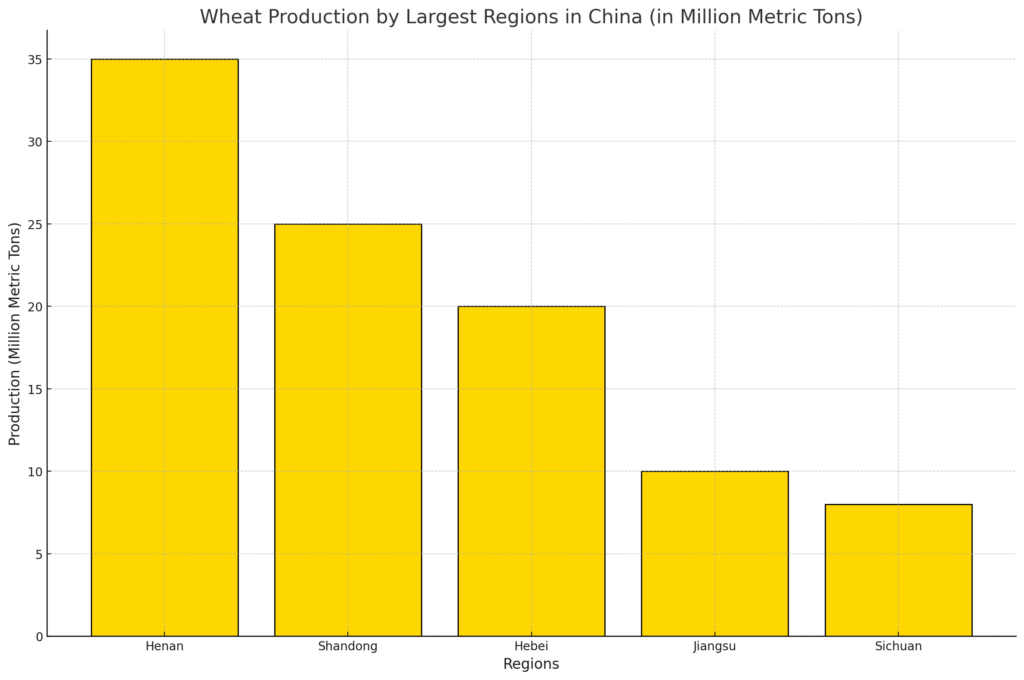
China, a global agricultural powerhouse, is one of the world’s largest producers of wheat. With its vast lands and advanced farming practices, the country’s top wheat-producing regions play a critical role in ensuring food security domestically and globally. In this article, we delve into the largest wheat-producing regions in China, their unique characteristics, and their contribution to the wheat industry.

1. Henan Province: The Wheat Powerhouse
Henan, located in central China, is the country’s leading wheat-producing region, often referred to as the “granary of China.”
Key Highlights:
- Annual Production: Over 35 million metric tons.
- Geographical Advantage: Fertile soil and a temperate climate make it ideal for wheat cultivation.
- Infrastructure: Advanced irrigation systems and high-tech harvesting equipment.
- Economic Impact: Henan’s wheat industry supports local farmers and contributes significantly to the national economy.
Henan’s dominance stems from its efficient farming techniques and government-backed agricultural initiatives.
2. Shandong Province: A Major Contributor
Shandong, located in eastern China, is another top wheat-producing region known for its high-quality grains.
Key Highlights:
- Annual Production: Approximately 25 million metric tons.
- Climate: Moderate rainfall and fertile plains provide optimal growing conditions.
- Export Potential: Shandong’s proximity to ports facilitates wheat exports.
- Sustainability Efforts: The region focuses on eco-friendly farming and water conservation practices.
Shandong’s strategic location and commitment to sustainability make it a crucial player in China’s wheat industry.
3. Hebei Province: A Wheat Giant
Hebei, situated near Beijing, is a significant contributor to China’s wheat supply.
Key Highlights:
- Annual Production: Around 20 million metric tons.
- Agricultural Practices: Combines traditional farming methods with modern technology.
- Market Integration: Supplies wheat to both domestic markets and neighboring regions.
- Challenges: Hebei faces water scarcity issues, but ongoing innovations are mitigating these challenges.
Hebei’s ability to adapt to environmental challenges ensures its continued relevance in wheat production.
4. Jiangsu Province: Balancing Wheat and Rice
While Jiangsu is known for its rice production, it also ranks high in wheat cultivation.
Key Highlights:
- Annual Production: Approximately 10 million metric tons.
- Agricultural Diversity: Supports a mix of wheat and rice farming.
- Innovation: Investments in crop rotation and smart farming technology.
- Economic Role: Wheat farming supports rural communities and boosts the local economy.
Jiangsu’s diverse agricultural output underscores its importance in China’s food security strategy.
5. Sichuan Province: A Rising Star
Sichuan, in southwestern China, is an emerging wheat-producing region, leveraging its agricultural diversity.
Key Highlights:
- Annual Production: Around 8 million metric tons.
- Favorable Conditions: Mild climate and abundant rainfall support multiple harvests.
- Focus: The region is increasingly integrating wheat into its diverse agricultural portfolio.
- Future Potential: Government initiatives aim to expand wheat cultivation further.
Sichuan’s rising prominence is a testament to China’s efforts to diversify its agricultural landscape.

Factors Behind China’s Wheat Success
- Technological Advancements: Smart farming and mechanized agriculture boost productivity.
- Government Policies: Subsidies and support for farmers ensure steady growth.
- Efficient Supply Chains: Advanced logistics facilitate swift transportation and distribution.
Challenges in Wheat Production
- Climate Change: Erratic weather patterns impact yields.
- Water Scarcity: Overuse of groundwater affects long-term sustainability.
- Urbanization: Expanding cities encroach on agricultural lands.
The Future of Wheat Production in China
China’s top wheat-producing regions—Henan, Shandong, Hebei, Jiangsu, and Sichuan—are well-equipped to tackle challenges and meet growing demand. With continued innovation and strategic investments, these regions will remain central to China’s agricultural dominance.


